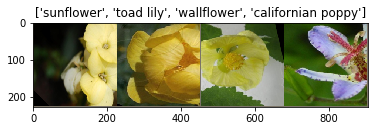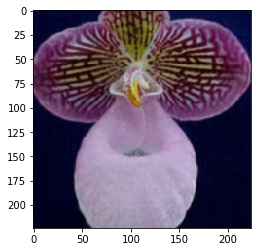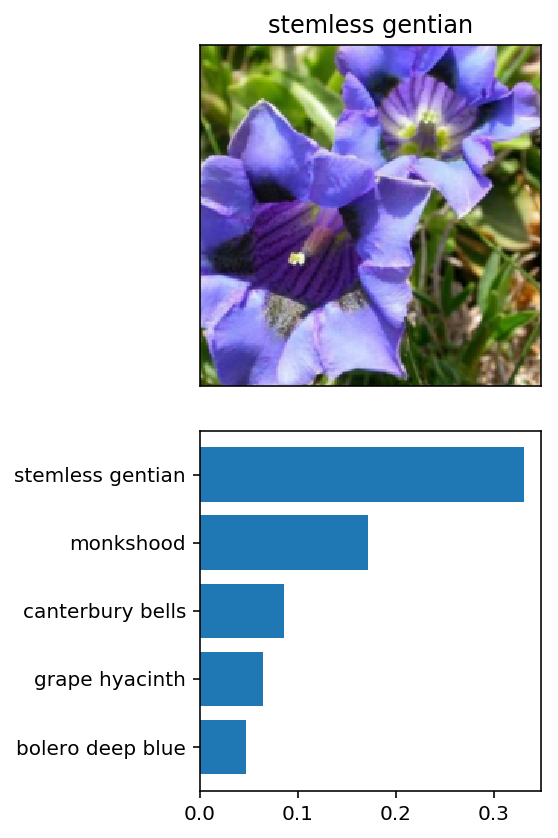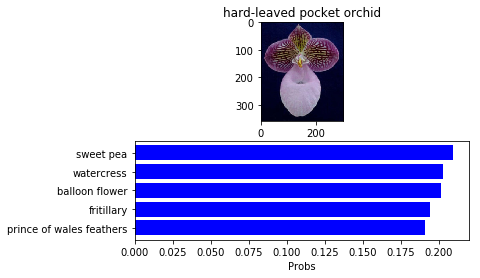README
Going forward, AI algorithms will be incorporated into more and more everyday applications. For example, you might want to include an image classifier in a smart phone app. To do this, you'd use a deep learning model trained on hundreds of thousands of images as part of the overall application architecture. A large part of software development in the future will be using these types of models as common parts of applications.
In this project, you'll train an image classifier to recognize different species of flowers. You can imagine using something like this in a phone app that tells you the name of the flower your camera is looking at. In practice you'd train this classifier, then export it for use in your application. We'll be using this dataset of 102 flower categories, you can see a few examples below.
The project is broken down into multiple steps:
- Load and preprocess the image dataset
- Train the image classifier on your dataset
- Use the trained classifier to predict image content
We'll lead you through each part which you'll implement in Python.
When you've completed this project, you'll have an application that can be trained on any set of labeled images. Here your network will be learning about flowers and end up as a command line application. But, what you do with your new skills depends on your imagination and effort in building a dataset. For example, imagine an app where you take a picture of a car, it tells you what the make and model is, then looks up information about it. Go build your own dataset and make something new.
First up is importing the packages you'll need. It's good practice to keep all the imports at the beginning of your code. As you work through this notebook and find you need to import a package, make sure to add the import up here.
# Please notice that some parts of this project are based on the official pytorch tutorial.
# https://pytorch.org/tutorials/beginner/transfer_learning_tutorial.html
%load_ext autoreload
%autoreload 2import torch
import torch.utils.data as data
import torchvision
import torchvision.transforms as transforms
import torchvision.datasets as datasets
import numpy as np
import matplotlib.pyplot as plt
import matplotlib.image as mpimg
from PIL import Image
import train
import predict
import jsonHere you'll use torchvision to load the data (documentation). The data should be included alongside this notebook, otherwise you can download it here. The dataset is split into three parts, training, validation, and testing. For the training, you'll want to apply transformations such as random scaling, cropping, and flipping. This will help the network generalize leading to better performance. You'll also need to make sure the input data is resized to 224x224 pixels as required by the pre-trained networks.
The validation and testing sets are used to measure the model's performance on data it hasn't seen yet. For this you don't want any scaling or rotation transformations, but you'll need to resize then crop the images to the appropriate size.
For all three sets you'll need to normalize the means and standard deviations of the images to what the network expects. For the means, it's [0.485, 0.456, 0.406] and for the standard deviations [0.229, 0.224, 0.225]. This converts the values of each color channel to be between -1 and 1 instead of 0 and 1.
data_dir = 'flowers'# Define your transforms for the training, validation, and testing sets
data_transforms = {
'train': transforms.Compose([
transforms.RandomRotation(45),
transforms.RandomResizedCrop(224),
transforms.RandomHorizontalFlip(),
transforms.ToTensor(),
transforms.Normalize(mean=[0.485, 0.456, 0.406], std=[0.229, 0.224, 0.225])
]),
'valid': transforms.Compose([
transforms.Resize(256),
transforms.CenterCrop(224),
transforms.ToTensor(),
transforms.Normalize(mean=[0.485, 0.456, 0.406], std=[0.229, 0.224, 0.225])
]),
'test': transforms.Compose([
transforms.Resize(256),
transforms.CenterCrop(224),
transforms.ToTensor(),
transforms.Normalize(mean=[0.485, 0.456, 0.406], std=[0.229, 0.224, 0.225])
])
}
# Load the datasets with ImageFolder
image_datasets = {
x: datasets.ImageFolder(root=data_dir + '/' + x, transform=data_transforms[x])
for x in list(data_transforms.keys())
}You'll also need to load in a mapping from category label to category name. You can find this in the file cat_to_name.json. It's a JSON object which you can read in with the json module. This will give you a dictionary mapping the integer encoded categories to the actual names of the flowers.
with open('cat_to_name.json', 'r') as f:
cat_to_name = json.load(f)Let’s visualize a few training images:
def imshow(inp, title=None):
"""Imshow for Tensor."""
inp = inp.numpy().transpose((1, 2, 0))
mean = np.array([0.485, 0.456, 0.406])
std = np.array([0.229, 0.224, 0.225])
inp = std * inp + mean
inp = np.clip(inp, 0, 1)
plt.imshow(inp)
if title is not None:
plt.title(title)
plt.pause(0.001) # pause a bit so that plots are updated
# Using the image datasets, define the dataloaders
dataloaders = {
x: data.DataLoader(image_datasets[x], batch_size=4, shuffle=True, num_workers=2)
for x in list(image_datasets.keys())
}
# Get a batch of training data
inputs, classes = next(iter(dataloaders['train']))
# Make a grid from batch
out = torchvision.utils.make_grid(inputs)
labels = list(cat_to_name.values())
imshow(out, title=[labels[x] for x in classes])Now that the data is ready, it's time to build and train the classifier. As usual, you should use one of the pretrained models from torchvision.models to get the image features. Build and train a new feed-forward classifier using those features.
We're going to leave this part up to you. If you want to talk through it with someone, chat with your fellow students! You can also ask questions on the forums or join the instructors in office hours.
Refer to the rubric for guidance on successfully completing this section. Things you'll need to do:
- Load a pre-trained network (If you need a starting point, the VGG networks work great and are straightforward to use)
- Define a new, untrained feed-forward network as a classifier, using ReLU activations and dropout
- Train the classifier layers using backpropagation using the pre-trained network to get the features
- Track the loss and accuracy on the validation set to determine the best hyperparameters
We've left a cell open for you below, but use as many as you need. Our advice is to break the problem up into smaller parts you can run separately. Check that each part is doing what you expect, then move on to the next. You'll likely find that as you work through each part, you'll need to go back and modify your previous code. This is totally normal!
When training make sure you're updating only the weights of the feed-forward network. You should be able to get the validation accuracy above 70% if you build everything right. Make sure to try different hyperparameters (learning rate, units in the classifier, epochs, etc) to find the best model. Save those hyperparameters to use as default values in the next part of the project.
model = train.train_model(image_datasets, arch='alexnet', gpu=True, epochs=14, hidden_units=4096)Network architecture: alexnet
Number of hidden units: 4096
Number of epochs: 14
Learning rate: 0.001
Using GPU for training
Epoch 1/14
----------
train Loss: 4.5515 Acc: 0.0333
valid Loss: 3.8531 Acc: 0.2098
Epoch 2/14
----------
train Loss: 3.7148 Acc: 0.1392
valid Loss: 2.8058 Acc: 0.3029
Epoch 3/14
----------
train Loss: 2.9810 Acc: 0.2500
valid Loss: 2.1294 Acc: 0.4520
Epoch 4/14
----------
train Loss: 2.6074 Acc: 0.3294
valid Loss: 1.8415 Acc: 0.5294
Epoch 5/14
----------
train Loss: 2.2126 Acc: 0.4127
valid Loss: 1.6776 Acc: 0.5392
Epoch 6/14
----------
train Loss: 2.0053 Acc: 0.4549
valid Loss: 1.5599 Acc: 0.5588
Epoch 7/14
----------
train Loss: 1.9235 Acc: 0.4794
valid Loss: 1.3756 Acc: 0.6265
Epoch 8/14
----------
train Loss: 1.5538 Acc: 0.5990
valid Loss: 1.1930 Acc: 0.6814
Epoch 9/14
----------
train Loss: 1.3817 Acc: 0.6206
valid Loss: 1.1466 Acc: 0.6863
Epoch 10/14
----------
train Loss: 1.3306 Acc: 0.6520
valid Loss: 1.1130 Acc: 0.6980
Epoch 11/14
----------
train Loss: 1.3506 Acc: 0.6412
valid Loss: 1.1032 Acc: 0.6941
Epoch 12/14
----------
train Loss: 1.3369 Acc: 0.6382
valid Loss: 1.0924 Acc: 0.6990
Epoch 13/14
----------
train Loss: 1.2928 Acc: 0.6392
valid Loss: 1.0696 Acc: 0.7020
Epoch 14/14
----------
train Loss: 1.2130 Acc: 0.6471
valid Loss: 1.0585 Acc: 0.7078
Training complete in 1m 15s
Best val Acc: 0.707843
It's good practice to test your trained network on test data, images the network has never seen either in training or validation. This will give you a good estimate for the model's performance on completely new images. Run the test images through the network and measure the accuracy, the same way you did validation. You should be able to reach around 70% accuracy on the test set if the model has been trained well.
phase = 'test'
correct = 0
total = 0
with torch.no_grad():
if torch.cuda.is_available():
print("Using GPU")
device = torch.device("cuda:0")
else:
print("Using CPU")
device = torch.device("cpu")
for inputs, labels in dataloaders[phase]:
inputs = inputs.to(device)
labels = labels.to(device)
outputs = model(inputs)
_, predicted = torch.max(outputs.data, 1)
total += labels.size(0)
correct += (predicted == labels).sum().item()
print('Accuracy of the network on the test images: %d %%' % (
100 * correct / total))Using GPU
Accuracy of the network on the test images: 67 %
Now that your network is trained, save the model so you can load it later for making predictions. You probably want to save other things such as the mapping of classes to indices which you get from one of the image datasets: image_datasets['train'].class_to_idx. You can attach this to the model as an attribute which makes inference easier later on.
model.class_to_idx = image_datasets['train'].class_to_idx
Remember that you'll want to completely rebuild the model later so you can use it for inference. Make sure to include any information you need in the checkpoint. If you want to load the model and keep training, you'll want to save the number of epochs as well as the optimizer state, optimizer.state_dict. You'll likely want to use this trained model in the next part of the project, so best to save it now.
# Save a checkpoint
model.class_to_idx = image_datasets['train'].class_to_idx
checkpoint = {
'arch': 'alexnet',
'class_to_idx': model.class_to_idx,
'state_dict': model.state_dict(),
'hidden_units': 4096
}
torch.save(checkpoint, 'my_model.pt')At this point it's good to write a function that can load a checkpoint and rebuild the model. That way you can come back to this project and keep working on it without having to retrain the network.
checkpoint = torch.load('my_model.pt')
arch = checkpoint['arch']
num_labels = len(checkpoint['class_to_idx'])
hidden_units = checkpoint['hidden_units']
model = train.load_model(arch=arch, num_labels=num_labels, hidden_units=hidden_units)
model.load_state_dict(checkpoint['state_dict'])
model.class_to_idx = checkpoint['class_to_idx']Now you'll write a function to use a trained network for inference. That is, you'll pass an image into the network and predict the class of the flower in the image. Write a function called predict that takes an image and a model, then returns the top
probs, classes = predict(image_path, model)
print(probs)
print(classes)
> [ 0.01558163 0.01541934 0.01452626 0.01443549 0.01407339]
> ['70', '3', '45', '62', '55']First you'll need to handle processing the input image such that it can be used in your network.
You'll want to use PIL to load the image (documentation). It's best to write a function that preprocesses the image so it can be used as input for the model. This function should process the images in the same manner used for training.
First, resize the images where the shortest side is 256 pixels, keeping the aspect ratio. This can be done with the thumbnail or resize methods. Then you'll need to crop out the center 224x224 portion of the image.
Color channels of images are typically encoded as integers 0-255, but the model expected floats 0-1. You'll need to convert the values. It's easiest with a Numpy array, which you can get from a PIL image like so np_image = np.array(pil_image).
As before, the network expects the images to be normalized in a specific way. For the means, it's [0.485, 0.456, 0.406] and for the standard deviations [0.229, 0.224, 0.225]. You'll want to subtract the means from each color channel, then divide by the standard deviation.
And finally, PyTorch expects the color channel to be the first dimension but it's the third dimension in the PIL image and Numpy array. You can reorder dimensions using ndarray.transpose. The color channel needs to be first and retain the order of the other two dimensions.
# Process a PIL image for use in a PyTorch model
def process_image(image):
''' Scales, crops, and normalizes a PIL image for a PyTorch model,
returns an Numpy array
'''
img_loader = transforms.Compose([
transforms.Resize(256),
transforms.CenterCrop(224),
transforms.ToTensor()])
pil_image = Image.open(image)
pil_image = img_loader(pil_image).float()
np_image = np.array(pil_image)
mean = np.array([0.485, 0.456, 0.406])
std = np.array([0.229, 0.224, 0.225])
np_image = (np.transpose(np_image, (1, 2, 0)) - mean)/std
np_image = np.transpose(np_image, (2, 0, 1))
return np_imageTo check your work, the function below converts a PyTorch tensor and displays it in the notebook. If your process_image function works, running the output through this function should return the original image (except for the cropped out portions).
def imshow(image, ax=None, title=None):
"""Imshow for Tensor."""
if ax is None:
fig, ax = plt.subplots()
# PyTorch tensors assume the color channel is the first dimension
# but matplotlib assumes is the third dimension
image = np.transpose(image, (1, 2, 0))
# Undo preprocessing
mean = np.array([0.485, 0.456, 0.406])
std = np.array([0.229, 0.224, 0.225])
image = std * image + mean
# Image needs to be clipped between 0 and 1 or it looks like noise when displayed
image = np.clip(image, 0, 1)
ax.imshow(image)
return ax%matplotlib inline
_= imshow(process_image('sample_img.jpg'))Once you can get images in the correct format, it's time to write a function for making predictions with your model. A common practice is to predict the top 5 or so (usually called top-$K$) most probable classes. You'll want to calculate the class probabilities then find the
To get the top x.topk(k). This method returns both the highest k probabilities and the indices of those probabilities corresponding to the classes. You need to convert from these indices to the actual class labels using class_to_idx which hopefully you added to the model or from an ImageFolder you used to load the data (see here). Make sure to invert the dictionary so you get a mapping from index to class as well.
Again, this method should take a path to an image and a model checkpoint, then return the probabilities and classes.
probs, classes = predict(image_path, model)
print(probs)
print(classes)
> [ 0.01558163 0.01541934 0.01452626 0.01443549 0.01407339]
> ['70', '3', '45', '62', '55']probs, classes = predict.predict(image='sample_img.jpg', checkpoint='my_model.pt', labels='cat_to_name.json', gpu=True)
print(probs)
print(classes)[0.22858675 0.20332417 0.19544812 0.18642561 0.18621536]
['primula', 'daffodil', 'carnation', 'trumpet creeper', 'moon orchid']
Now that you can use a trained model for predictions, check to make sure it makes sense. Even if the testing accuracy is high, it's always good to check that there aren't obvious bugs. Use matplotlib to plot the probabilities for the top 5 classes as a bar graph, along with the input image. It should look like this:
You can convert from the class integer encoding to actual flower names with the cat_to_name.json file (should have been loaded earlier in the notebook). To show a PyTorch tensor as an image, use the imshow function defined above.
# Display an image along with the top 5 classes
img = mpimg.imread('sample_img.jpg')
f, axarr = plt.subplots(2,1)
axarr[0].imshow(img)
axarr[0].set_title('hard-leaved pocket orchid')
probs, classes = predict.predict(image='sample_img.jpg', checkpoint='my_model.pt', labels='cat_to_name.json', gpu=True)
y_pos = np.arange(len(classes))
axarr[1].barh(y_pos, probs, align='center', color='blue')
axarr[1].set_yticks(y_pos)
axarr[1].set_yticklabels(classes)
axarr[1].invert_yaxis() # labels read top-to-bottom
_ = axarr[1].set_xlabel('Probs')



